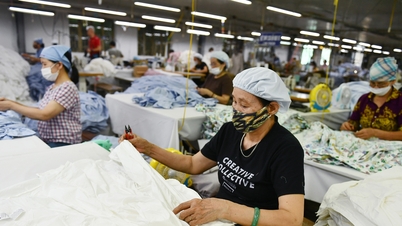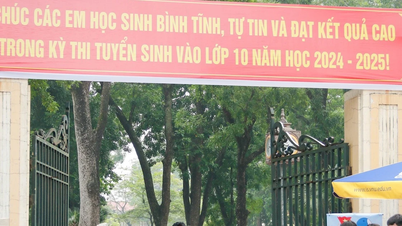Environment and Agriculture-Forestry-Fisheries are the two leading fields in terms of student employment rate, according to the Ministry of Education and Training.
The information is stated in the report on student employment in the period 2018-2021 of the Ministry of Education and Training, announced on the morning of May 26. Accordingly, except for 2019, the rate of students having jobs after 12 months of graduation in this period is always above 90%.
Among 22 training fields, Environment and Environmental Protection leads in the rate of students having jobs in 2021. Following are Agriculture-Forestry-Fisheries and Arts.
In particular, Agriculture, Forestry, Fisheries and Social Services are two fields with the lowest enrollment for many years, but they lead in the rate of students finding jobs. Each year, these two fields only recruit about 50% of the quota.
The most popular fields of study for applicants, such as Business and Management, and Computer and Information Technology, have all been in the top 10 in terms of employment rates in the last three admissions cycles, with 92.2 and 93.5% respectively. Last year, of the approximately half a million students enrolled, the number of students choosing these two fields was 26% and 13%.
Dr. Pham Nhu Nghe, Director of the Department of Higher Education, assessed that the rate of students finding jobs after 12 months is not low. However, the survey in the first stage has not analyzed whether students are working in the right field of study and have stable salaries or not.
Since 2016, the Ministry of Education and Training has required universities to report the results of a survey on the employment situation of students 12 months after graduation. This is one of the criteria for schools to propose enrollment targets. If the rate of students with jobs 12 months after graduation is below 80%, those majors will not be allowed to increase their quotas.
"When evaluating a university, there are many different criteria, including a very important criterion: the rate of students having jobs after graduation. It cannot be said that a university is prestigious if the rate of students having jobs is low," said Mr. Nghe.
The employment rate of students in 22 fields in the period 2019-2021 (percentage) is as follows:
TT | Training field | 2021 | 2020 | 2019 |
1 | Environment and Environmental Protection | 96.3 | 92.3 | 62.5 |
2 | Agriculture-Forestry-Fisheries | 95.7 | 95.8 | 86 |
3 | Art | 95.5 | 95.5 | 95.3 |
4 | Computers and Information Technology | 93.5 | 91.8 | 93.7 |
5 | Social Services | 93.1 | 95.8 | 98.4 |
6 | Health | 93.1 | 89.6 | 88.4 |
7 | Engineering technology | 93.1 | 90.8 | 91.6 |
8 | Technique | 92.6 | 94.4 | 90.6 |
9 | Business and Management | 92.2 | 92.8 | 91.4 |
10 | Humanities | 91.9 | 91.9 | 89.7 |
11 | Social and Behavioral Sciences | 91.7 | 91.8 | 73.4 |
12 | Press and Information | 90.9 | 90 | 85 |
13 | Mathematics and Statistics | 90.5 | 96.4 | 95.1 |
14 | Production and Processing | 90.5 | 88.5 | 89.8 |
15 | Veterinary | 88.3 | 89.4 | 85.4 |
16 | Life Sciences | 87.5 | 88.9 | 90.3 |
17 | Educational Science and Teacher Training | 87.4 | 91.9 | 87.4 |
18 | Architecture and Construction | 87.3 | 80.2 | 84.8 |
19 | Natural Science | 86.8 | 85.5 | 77.8 |
20 | Law | 86.1 | 88.3 | 86.2 |
21 | Transportation Services | 84.7 | 89.5 | 89.5 |
22 | Travel, Hospitality, Sports and Personal Services | 82.5 | 81.8 | 75 |
Some fields have low employment rates for students such as Tourism, Hospitality, Sports and Personal Services; Transportation Services. Mr. Nghe said that the reason is due to training problems at school and the labor market.
According to him, the quality of higher education in our country is still modest, many majors of students do not meet the needs of businesses. Many skills that businesses need but students do not meet the requirements after graduation. On average, each university cooperates with about 60 businesses. However, the quality and effectiveness of cooperation between universities and businesses is still limited.
In addition, the Vietnamese labor market is on the rise, the number of new jobs created each year is often lower than the number of university graduates. The Deputy Director of the Department of Higher Education pointed out that in order to link university training with the needs of the labor market, human resource planning is decisive.

Mr. Pham Nhu Nghe at the forum on Developing cooperation between schools and businesses. Photo: BKU
Currently, there are about 180 universities nationwide. The total number of university enrollment targets for 2022 is 560,000. The Ministry of Education and Training said that more than 521,000 candidates were admitted.
Tuition fees for public universities for mass programs are mainly VND1.43 million per month. However, from next year, the tuition ceiling for schools that have not covered their regular expenses (not yet autonomous) will be VND1.41-2.76 million per month, depending on the major. For schools that are autonomous or have joint programs that are accredited domestically and internationally, tuition fees will be higher.
According to the General Statistics Office, in 2021, the average income of workers with a university degree or higher is more than 9.2 million VND per month.
Le Nguyen
Source link




![[Photo] President Luong Cuong attends the inauguration of the international container port in Hai Phong](https://vphoto.vietnam.vn/thumb/1200x675/vietnam/resource/IMAGE/2025/5/13/9544c01a03e241fdadb6f9708e1c0b65)


![[Photo] Prime Minister Pham Minh Chinh meets with US business representatives](https://vphoto.vietnam.vn/thumb/1200x675/vietnam/resource/IMAGE/2025/5/13/5bf2bff8977041adab2baf9944e547b5)






























































































Comment (0)